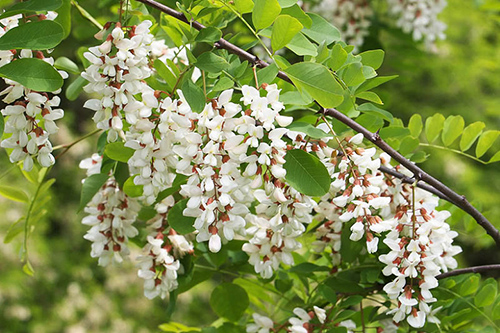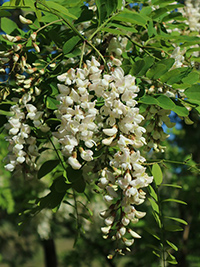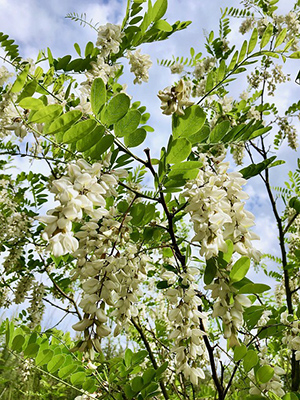Contents
The false acacia plant was introduced to Europe in 1601 by Jean Robin, Gardner of the King of France. However, its scientific name (Robinia) and its common names, too. Though used as an ornamental plant, it has interesting medicinal properties. With the nectar of its flowers, bees produce a highly desired honey.

False Acacia Scientific Facts
- Other names: Robinia.
- French: Robinier, faux acacia.
- Spanish: Falsa acacia, robinia.
- Environment: Native to North America, at present, it is cultivated as an ornamental plant worldwide.
- Description: The tree of the Leguminosae family grows from 4 to 20 m high, with thorny branches and white flowers growing in hanging clusters.
- Parts of the plant used medicinally: The flowers and the leaves.
Healing Properties and Warning

The flowers and the leaves contain flavonoids, glycosides (robinine), tannin, and essential oil. They have antispasmodic (alleviating the spasms of hollow organs), cholagogue (easing the emptying of bile), and emollient (soothing skin and mucosa) properties. They are used as stomachic for dyspepsia and gall bladder disorders. Due to their emollient properties, they protect the esophagus and stomach mucous membranes from an excess of acidity. They are recommended for pyrosis (acidity), esophagitis, and gastro-duodenal ulcers. When taken in gargles, they alleviate throat irritation.
WARNING! The seeds, the bark, and the root, despite their sweet flavor, are toxic and cause vomiting.

Gum Arabic
When bleeding the branches of other Acacia species, which belong to the Mimosaceae family, and especially those of Acacia nilotica (L.) Del (= Acacia arabica [Lasm.] Wild. = Mimosa nilotica L.) gum arabic is obtained.
This substance has excellent emollient properties, is beneficial in treating digestive mucosal inflammation, and is part of many syrups and pharmaceutical preparations. Gum Arabic, which is a tree, is cultivated in tropical Africa Asia, and America, especially in Brazil and Argentina, where its leaves and fruits are sometimes used as forage, and the fiber is employed in rope making.
How to use False Acacia
- Infusion with 15-30g of flowers per liter of water. The recommended intake is one cup after each meal.
- Gargles with the infusion above.
DISCLAIMER: All content on this website is presented solely for educational and informational objectives. It would be best to not rely on the information provided as a replacement for advice, diagnosis, or treatment from a qualified medical expert. If you are pregnant, nursing, or have any preexisting medical concerns, you should talk to your doctor before using any herbal or natural medicines.
REFERENCES
- George D. Pamplona-Roger, M.D. “Encyclopedia of Medicinal Plants.” George D. Pamplona-Roger, M.D. Encyclopedia of Medicinal Plants. Ed. Francesc X. Gelabert. vols. 2 San Fernando de Henares: Editorial Safeliz, 2000. 469. Print. [false acacia]
- Herbal Medicine: Biomolecular and Clinical Aspects, 2nd edition – Chapter 3: Medicinal Plants in Neurodegenerative and Neurological Disorders https://www.ncbi.nlm.nih.gov/books/NBK92758/: This book chapter provides an overview of the medicinal properties of false acacia and its potential health benefits.
- Traditional and Modern Uses of Natural Honey in Human Diseases: A Review https://www.ncbi.nlm.nih.gov/pmc/articles/PMC5424551/: This review article discusses the traditional uses of false acacia honey in treating various health conditions.
